-
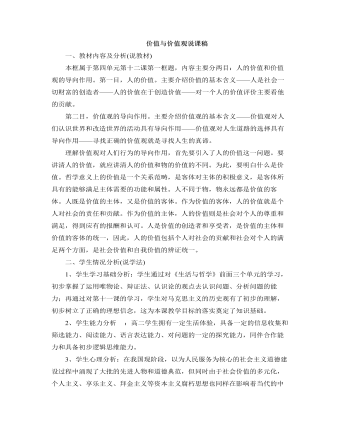
人教版高中政治必修4价值与价值观说课稿(二)
二、学生情况分析(说学法)1、学生学习基础分析:学生通过对《生活与哲学》前面三个单元的学习,初步掌握了运用唯物论、辩证法、认识论的观点去认识问题、分析问题的能力;再通过对第十一课的学习,学生对马克思主义的历史观有了初步的理解,初步树立了正确的理想信念,这为本课教学目标的落实奠定了知识基础。 2、学生能力分析 :高二学生拥有一定生活体验,具备一定的信息收集和筛选能力、阅读能力、语言表达能力、对问题的一定的探究能力,同伴合作能力和具备初步逻辑思维能力。3、学生心理分析:在我国现阶段,以为人民服务为核心的社会主义道德建设过程中涌现了大批的先进人物和道德典范,但同时由于社会价值的多元化,个人主义、享乐主义、拜金主义等资本主义腐朽思想也同样在影响着当代的中学生。

人教版高中英语必修1Journey Down the Mekong说课稿
2. let the Ss complete the forms paragraph by paragraph. Purpose here is to help Ss to get the habit of reading a passage as a whole, and pay attention to the organization of the text, as a result the Ss will fully understand the whole passage.3. ask Ss to retell the passage with the help of the key words in the form.Since the Ss in the class are in different levels, so I let them to fill in the blank to understand the meaning of the words and phrases better. ( That’s all for the while-reading. Now let’s move to the fifth step.)Step V: Post-reading (10mins) ---DiscussionIn this part students are asked to discuss in groups and list Wang Kun’s and Wang Wei’s attitudes about the trip. After that, Ss are encouraged to express their attitudes with the whole class. Collect their answers and don’t forget to praise them even if their answers may not be perfect.In this activity, discussion provides a vivid and active learning environment for Ss to communicate in English with newly learned language items. (Finally it comes to the homework.)StepⅥ: Homework (1min)1. Ss are required to read the text again after class and figure out the meaning of some complex sentences.2. Do the exercises on P19; This can help Ss to consolidate what they’ve learnt and make preparation for the next lessonPart4. Blackboard design.(说板书设计)On the top, there is the title of this lesson. On the left, there are main ideas for each paragraph. On the right, there are some new words and expressions.Unit 3 Travel journalJourney down the MekongMain idea of each para.:Para1: deciding to take a great bike trip along the Mekong river.Para2: Different attitudes between Wang kun and Wang wei.

人教版高中英语必修4Body Language说课稿4篇
Textbook: Senior English for China (Book 4), by Liu Daoyi Time Allotment: 1 period (40 minutes)Date: March 20, 2014Teaching aids: blackboard, Multi-media, Power Point, chalk I. Text Analysis (教材分析)This unit is about body language, and the text selected in the reading part demonstrates the difference and similarity of body language in many parts of the world. Through learning this passage, students are required to raise their awareness of using body language in different parts of the world. As body language is closely related to our daily life, it is easy to arouse students’ interest in learning this text. Reading skills and speaking training are designed around the text.II. Teaching Objectives (教学目标)By the end of the lesson, students will be able to:1. Language Skill Objective(语言技能目标): develop reading ability (skimming and scanning)as well as speaking ability.2. Cultural Knowledge Objective(文化知识目标): know about the cultural differences of using body language.3. Affective Objective(情感目标): increase students’ awareness of using body language correctly in different cultures. III.Teaching Focuses and Difficulties(教学重点和难点)1. Teaching Focuses(教学重点): the difference and similarity of body language in many parts of the world.2. Teaching Difficulties(教学难点): develop students’ reading abilities of skimming and scanning and ask the students to show their opinions with fluent English.

人教版高中英语必修1Nelson Mandela--A Modern Hero说课稿
In this step, give students a few minutes to read the passage . While they are reading, I will write some key words of the text on the blackboard. Then ask students to retell the passage according to the key words.By retelling, students can improve their ability of language organization and have an overall understanding of the article.Step 4 Group discussionIn this step, students will be divided into groups of 4 to discussion the following question: What qualities make a great person?After their discussion, invite a few groups to make a report to the class.This group discussion can practice students’ oral English and cultivate their abilities of cooperation and communication.Step 5. HomeworkLet students write a short passage to introduce a great person he or she admires.The homework can consolidate the knowledge the students have learned and cultivate their writing ability. Part 6 Blackboard Design(板书设计)That’s all my teaching procedures. Finally, I’d like to say sth about part 6 blackboard design. On the top is the title. On the left, there will be some new words and expressions. In the middle of the blackboard, I will write some useful sentence structures so that the students can know clearly what they’ve learned and then try to master the knowledge.OK. That’s all for my presentation. Thank you for your attention.

人教版高中英语必修2The Olympic Games说课稿2篇
Purpose of my design:To ask the students to do these two tasks will make the Ss predict the story of this passage. As a result, it will deepen Ss’ memory of this story because they will have their own understanding of this story.Step 3. While-readingTask 1. (Individual work _____min)Skimming: ask students to skim the text and the main ideas of each paragraph in this passage. Please read it quickly and then match the sentences with the letters.Task 2. (Individual work _____min)Scanning: read the text quickly and decide the whether the following statements are true or false and give reasons.Task 3. (Pair work _____min)Listen to the tape and fill in the banks. Then read the paragraph with expression to your partner.Task4 (individual work min)Listen to the tape again and write down the main idea in one sentence.Purpose of my design: Enable students to understand the given material better by using different reading skills. And proper competition can arouse the Ss’ interest in English learning. “Task-based” teaching method is used here todevelop the Ss’ ability of communication and also their ability of co-operation will be well trainedStep 4. Post-readingTask 1. (Individual work, pair work, group work, class work; _____min)Discussion (group of 4):1. If you were Hippomenes, would you run against Atlanta?2. Do you think Hippomenes deserved to win the race? Why or why not?Step 5. HomeworkPlease read the story again carefully after class and imagine: What will happen during the race between Hippomenes and Atlanta? Who do you think will win the race? Do you think Atlanta would marry Hippomenes? Write an end for the story with thses questions.Purpose of my design: Homework is so important and necessary for to master the knowledge they learned after class. It will check whether the Ss achieve the teaching aims.Part 5 Blackboard design

人教版高中英语必修4A taste of English Humor说课稿3篇
Then I would ask them to think of a funny English or Chinese and tell it to partners. While telling stories, they can use expressions and some acting to help make the story funny. 5 minutes would be given to do this.Those stories they told there will be the material for their writing. Soletting them tell it at first is helpful. And they can make a difference between telling a funny story and writing it down. Generally speaking, it is difficult forstudents to write well because they don’t know what to write and how to write. Asking them to tell their own stories at first can help them come up with what to write.After their telling, I would invite someone to share his/her story with all of us and I would write it down on the blackboard.This example story would be used as a sample to illustrate the format of funny story. Different from a story from teacher or textbook, a story from students can obviously become a interesting material to draw students’ attention.Then I would ask the whole class to put this story into several parts. It might be a little bit difficult for them. So I would ask them to find out whether all the sentences are necessary. After delete some sentences, there are 6 sentences left behind. Then they can easily put them into three parts. After interaction with students, I would teach them the right terms for each part and conclude the format of funny story.This step is the key and difficult point in my lesson. So I mainly usetask-based teaching method in this part and the task for students was divided into several stages. With the separated difficult level, students can find there are usually three parts in writing. They can also learn to write without the unnecessary parts in the process of analyzing. And then I wouldn’t rush to tell them the right terms to them directly. Instead, I would ask them to name them by their own. A confused mind is better for acquiring knowledge.While-writing:Then I would give students 7 minutes to write down this story, without other requirements.With all the preparations in pre-writing, students’ difficulties were cleared. So it would be much easier for them to write down the story within 7 minutes. There are no other requirements because students’ first writing is actually a drafting. It would be revise and edit several times later. Writing, as a skill

人教版高中英语必修3Festivals around the World说课稿3篇
Teaching plan for Unit 1 book3Good morning, teachers. It’s my great pleasure to be here because I can share my lesson with you and I can learn a lot from it. I’ll begin my lesson from the following four parts, the teaching material, the teaching methods, the studying methods and the teaching procedure.Firstly, let me talk about the teaching material. The content of my lesson is the reading passage festivals and celebrations of Unit 1 Festivals around the world. This passage is about festivals and celebrations. By studying this passage, we’ll enable the students to know that festivals exit everywhere, and many of festivals in different countries celebrate similar ideas. As we all know, the reading passage is the center of each unit. If the Ss can learn it well, it will be helpful to make the Ss learn the rest of this unit.After studying the teaching material, I think the teaching aims are as the followings:1. Knowledge aims:(1) The Ss can master the usage of the important words andexpressions.(2)The Ss can use the __________________ (grammar) in the proper situation.Make students know about the festivals all over the world and the detail of the festivals, such as origin, content, and the date of the holiday festivals.2. Ability aims:(1) Students can talk about festivals and celebrations in English(2) To improve the student’s reading ability, especially their skimming and scanning ability.3. Emotion aims:Make the Ss know about the foreign festivals, and respect other countries’ custom.Next, let’s come to the important points and the difficult points.The important point is how to make the Ss understand the text better and the difficult point is how can they talk about it. secondly, Teaching Methods:1. task-based Language Teaching2. Computer assisted language teaching.3. question-and–answer methodThirdly, Studying Methods:

人教版高中英语必修4Working The Land说课稿3篇
Knowledge objectives:(1) to make Ss grasp the usage of words, expressions and sentence structures: statistics, struggle, thanks to, rid of, some patterns for persuasion, the “ing” form as subject and object;(2)to use learnt knowledge to persuade sb.Ability objectives:(1) to develop Ss’ reading skills(skimming, scanning, word guessing);(2) to improve Ss’ speaking, communicating and cooperating skills.Emotional objectives:to make Ss know the contribution of Yuan,and learn his spirit and his simple life time.Teaching important and difficult points:(1) some words, expressions and sentence structures mentioned above;(2)the content of the text;(3)training their reading and speaking skills.Teaching methods: CLT, TBLT,QT.Learning strategies: CLS, QLS, TBLS.Teaching procedures:Step 1 lead-in: (1) teacher plays a piece of recent news from CCTV about the harvest of the super hybrid rice, and ask students whether they know Yuan or not, and talk about him and his contribution.(2)Brain storm: let Ss describe Yuan in their minds including his appearance, his living condition and so on.Step 2 fast reading tasks:(1)teacher introduces Yuan and super hybrid rice(2)make Ss read the text as fast as possible with questions. Such as: what’s the general ideaof this passage? What’s Yuan’ dream? (skimming and scanning skill)Step 3 intensive reading tasks(1)let Ss read the text silently, find topic sentence of each paragraph and draw the difficult sentences and the knowledge what they don’t understand.(words guessing)(2)teacher and Ss talk about the important words, expressions and sentences together, and ask Ss to retell the content of the text.(summarizing and paraphrasing)(3)teacher summarize this part.(4) read again following the courseware.

人教版高中英语必修5Great scientists说课稿4篇
通过写文章梗概,培养学生综合运用语言的能力,学习用恰当的英语描述科学家的故事。这是本课的教学难点。教师可以使用完形填空的方式来帮助学生整理语篇,从而来降低难度。本课的教学重点的突破方法是:在阅读前,让学生初步了解得出科学观点所需要的基本程序,从而轻松而自然地导入文章的阅读;在阅读过程中,由易到难设计快速阅读和精读的问题,层层推进各种阅读活动,让学生对阅读内容从整体感知到细节理解,最后深层读懂整篇文章,同时加强阅读策略的指导,让每个学生都主动参与课堂教学活动,最终达到提高阅读能力的目的。Step 4 Post-readingGroup Activities四人小组共同合作,在老师的适当指导下,就以下2个问题展开讨论,让学生就所知、所学、所感和所想融入话题,然后抽若干同学代表作小组发言。1. What do you think about John Snow, and what should we learn from him?2. Cholera was 19th century disease, which two diseases are similar to cholera today? Why?

人教版高中英语必修5The United Kingdom说课稿4篇
Teaching Aims:Knowledge 1. Get the students to learn the useful new words and expressions in this section. Aims:2. Let the students learn about how the UK was formed and the four groups of invaders.1. Develop students’ reading ability and let them learn different Ability reading skills. Aims:2. Enable students to learn to talk about the United Kingdom and the Union Jack Emotional 1. Let students know more about the UK2. Develop students’ sense of cooperative learning Aims:Teaching Important Points:1. Let the students learn about the countries of the United Kingdom and the Union Jack2. Get the students to read the passage and know about how the UK was formed and the four groups of invaders.3. Have the students learn different reading skills.Teaching Difficult Ponts:1. Develop students’ reading ability.2. Enable students to talk about the United Kingdom and the Union Jack.3. Let students learn how the UK was formed geographically and historically.Teaching Methods:Showing pictures, asking, exercising, listening, reading etc.Teaching Aids:A computer,a projector and a blackboard.Teaching Procedures: 1) Show a map of the world, ask students the following questions:Where is the UK?What’s the full name of the UK?2) Ask the students work in pairs to do the quiz on Page 9.Do you want to test how many things you know about the United Kingdom? Let’s have a small test.Using the map on P9, students answer the following questions:?How many countries does the UK consist of? What are they??England is divided into three main areas. Do you know what they are? 1) Scanning (10Minutes )Let the students hold the questions asked in pre-reading and read the passagequickly and then let them do the following exercise.Join lines to the right answer.
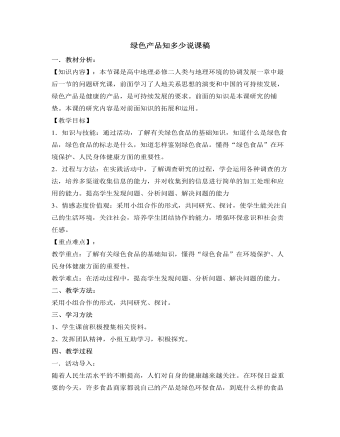
人教版高中地理必修2绿色产品知多少说课稿
各小组派代表汇报。4、教师提出问题组织学生讨论:⑴要想了解更多的绿色食品,了解绿色食品的销售情况,我们应该怎么做?⑵要想了解广大消费者对绿色食品的态度,食用绿色食品的意义,是否懂得辨认绿色食品,以及什么样的人群对此知识最缺乏等,我们应该怎么做?组织学生汇报交流。5、做个“绿色食品”广告设计师。为你喜欢的绿色食品设计广告语,每组推荐一个。6、让学生了解绿色食品认证程序。7、绿色食品打“假”队员在行动。8、向学生介绍生态绿色食品基地。三、活动总结:通过研究、探讨,了解学生对绿色食品的态度。提问:民以食为天,吃,是一个大问题,如果你的爸爸妈妈让你到超市买牛奶、方便面等,你会选择什么样的食品?为什么?希望通过今天的学习,同学们能够做到绿色消费,也希望你们向自己的家人、向周围的了解学生对“无公害食品”、“有机食品”与“绿色食品”的认识。
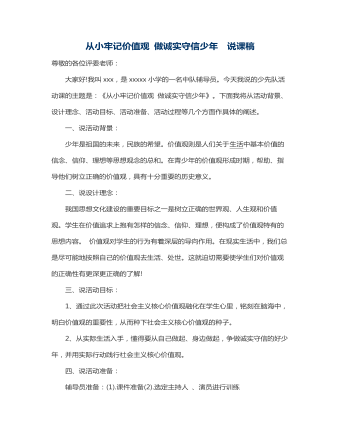
从小牢记价值观 做诚实守信少年-说课稿
尊敬的各位评委老师:大家好!我叫xxx,是xxxxx小学的一名中队辅导员。今天我说的少先队活动课的主题是:《从小牢记价值观 做诚实守信少年》。下面我将从活动背景、设计理念、活动目标、活动准备、活动过程等几个方面作具体的阐述。 一、说活动背景: 少年是祖国的未来,民族的希望。价值观则是人们关于生活中基本价值的信念、信仰、理想等思想观念的总和。在青少年的价值观形成时期,帮助、指导他们树立正确的价值观,具有十分重要的历史意义。 二、说设计理念: 我国思想文化建设的重要目标之一是树立正确的世界观、人生观和价值观。学生在价值追求上抱有怎样的信念、信仰、理想,便构成了价值观特有的思想内容。价值观对学生的行为有着深层的导向作用。在现实生活中,我们总是尽可能地按照自己的价值观去生活、处世。这就迫切需要使学生们对价值观的正确性有更深更正确的了解! 三、说活动目标: 1、通过此次活动把社会主义核心价值观融化在学生心里,铭刻在脑海中,明白价值观的重要性,从而种下社会主义核心价值观的种子。 2、从实际生活入手,懂得要从自己做起、身边做起,争做诚实守信的好少年,并用实际行动践行社会主义核心价值观。 四、说活动准备: 辅导员准备:(1).课件准备(2).选定主持人 、演员进行训练 (3).准备队旗等教具。 (4)收集社会主义核心价值体系内涵外延的材料等 学生准备:(1)搜集身边关于诚实守信的故事或行为 (2)初步了解什么是社会主义核心价值观,
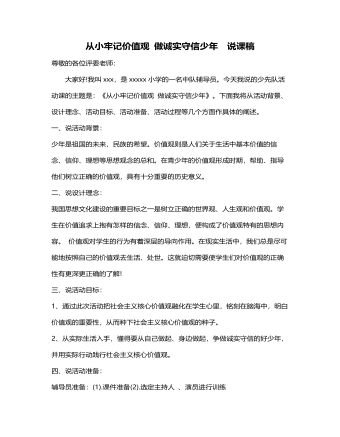
从小牢记价值观,做诚实守信少年说课稿
〖设计意图:使学生更深刻更正确地领悟价值观的重要作用,初步树立了正确的价值观,并下决心在价值观的引导下要做一位“诚实守信”的好少年。〗第四环节:快乐品味价值1. PPT分三个层面出示24字核心价值观,请全班同学集体朗诵,并尝试用自己的.话理解24个字的内涵。2.庄严宣誓中队长小结发言后一同面向队旗面向五星红旗庄严宣誓: 接着诵读梁启超先生的《少年中国说》〖通过这一环节让学生进一步巩固核心价值观并达到背诵的目的。让24个字融化在心间,铭刻在脑海里。〗以上四个环节由浅入深, 层层递进,充分调动了学生的多种感官参与活动,促进了学生身心和能力的发展,顺理成章的达到了本次活动的目的。以上就是我对《从小牢记价值观,做诚实守信少年》这节少先队活动课的阐述。存在的不足之处还恳请各位评委老师批评指正。谢谢!
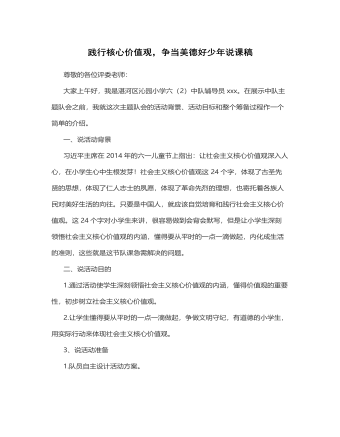
践行核心价值观,争当美德好少年说课稿
侯宇佳、孙誉函和刘入源同学,通过这个环节,我们想告诉大家:只要我们身边的小事做好了,那就是守纪律、讲文明的表现,就是爱学校爱国家的一种表现!最后我们小队全体队员齐唱《文明守纪歌》,让文明礼仪深深地在大家心中扎根。主持人乙:通过三个小队形式多样的展示,队员们对社会主义核心价值观有了更深刻的体会,最后我们让大家把自己的感悟写在心形纸上,写好后贴在教室墙壁的心愿树上。主持人甲:队员们有的写出了自己对祖国的美好祝愿,有的写出了文明宣传语,有的立志要做道德标兵.....我们的祖国如一棵大树,有了我们青少年的装扮和付出,这棵大树一定会枝繁叶茂,硕果累累的!5、说活动效果1.本节队会在队员们的精心准备下,内容充实、形式多样的表达了孩子们对社会主义核心价值观的理解,而且队员们能联系实际,将其内化成自己在学习和生活中的准则,真正使得社会主义核心价值观走进学生的心灵!
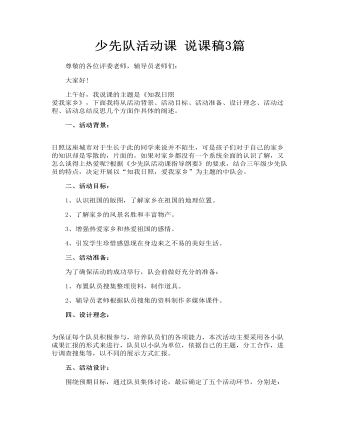
少先队活动课 说课稿3篇
一、活动背景: 日照这座城市对于生长于此的同学来说并不陌生,可是孩子们对于自己的家乡的知识却是零散的,片面的。如果对家乡都没有一个系统全面的认识了解,又怎么谈得上热爱呢?根据《少先队活动课指导纲要》的要求,结合三年级少先队员的特点,决定开展以“知我日照,爱我家乡”为主题的中队会。 二、活动目标: 1、认识祖国的版图,了解家乡在祖国的地理位置。 2、了解家乡的风景名胜和丰富物产。 3、增强热爱家乡和热爱祖国的感情。 4、引发学生珍惜感恩现在身边来之不易的美好生活。 三、活动准备: 为了确保活动的成功举行,队会前做好充分的准备: 1、布置队员搜集整理资料,制作道具。 2、辅导员老师根据队员搜集的资料制作多媒体课件。 四、设计理念: 为保证每个队员积极参与,培养队员们的各项能力,本次活动主要采用各小队成果汇报的形式来进行,队员以小队为单位,依据自己的主题,分工合作,进行调查搜集等,以不同的展示方式汇报。
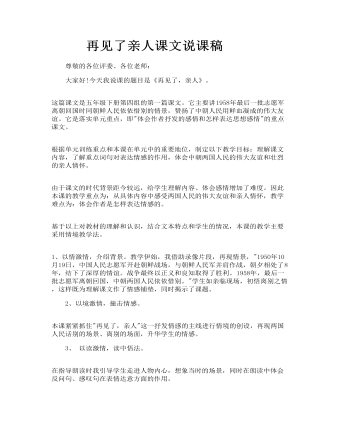
再见了亲人课文说课稿
1、以情激情,介绍背景。教学伊始,我借助录像片段,再现情景,"1950年10月19日,中国人民志愿军开赴朝鲜战场,与朝鲜人民军并肩作战,朝夕相处了8年,结下了深厚的情谊。战争最终以正义和良知取得了胜利。1958年,最后一批志愿军离朝回国,中朝两国人民依依惜别。"学生如亲临现场,初悟离别之情,这样既为理解课文作了情感铺垫,同时揭示了课题。 2、以境激情,撞击情感。 本课紧紧抓住"再见了,亲人"这一抒发情感的主线进行情境的创设,再现两国人民话别的场景、离别的场面,升华学生的情感。 3、 以读激情,读中悟法。 在指导朗读时我引导学生走进人物内心,想象当时的场景,同时在朗读中体会反问句、感叹句在表情达意方面的作用。 我根据这篇课文情感饱满、段落相似的特点,先引导学生初感文本,把握情感基调;再让学生说说触动自己情感之弦的语句和事例;然后以读为本,自悟自得。 围绕着文章的题眼,我精心抽取了"再见了,亲人"这条深情而厚重的丝线,拨动学生的心弦,设计了"讲亲人、诵亲人、别亲人"的大写意、"叠加式"结构。
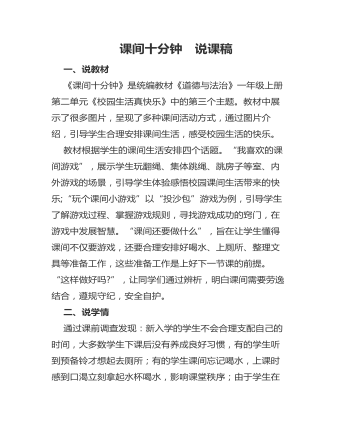
课间十分钟 说课稿
一、说教材《课间十分钟》是统编教材《道德与法治》一年级上册第二单元《校园生活真快乐》中的第三个主题。教材中展示了很多图片,呈现了多种课间活动方式,通过图片介绍,引导学生合理安排课间生活,感受校园生活的快乐。 教材根据学生的课间生活安排四个话题。“我喜欢的课间游戏”,展示学生玩翻绳、集体跳绳、跳房子等室、内外游戏的场景,引导学生体验感悟校园课间生活带来的快乐;“玩个课间小游戏”以“投沙包”游戏为例,引导学生了解游戏过程、掌握游戏规则,寻找游戏成功的窍门,在游戏中发展智慧。“课间还要做什么”,旨在让学生懂得课间不仅要游戏,还要合理安排好喝水、上厕所、整理文具等准备工作,这些准备工作是上好下一节课的前提。“这样做好吗?”,让同学们通过辨析,明白课间需要劳逸结合,遵规守纪,安全自护。二、说学情通过课前调查发现:新入学的学生不会合理支配自己的时间,大多数学生下课后没有养成良好习惯,有的学生听到预备铃才想起去厕所;有的学生课间忘记喝水,上课时感到口渴立刻拿起水杯喝水,影响课堂秩序;由于学生在生活中缺少与人交流、与群体游戏的机会,不知道如何安全游戏,大部分学生了解和掌握的课间游戏十分有限,所以造成课间疯跑追闹现象严重。需要教师引导学生尽快适应环境变化,了解校园生活规则,学会合理安排课间生活,感受校园生活的快乐。
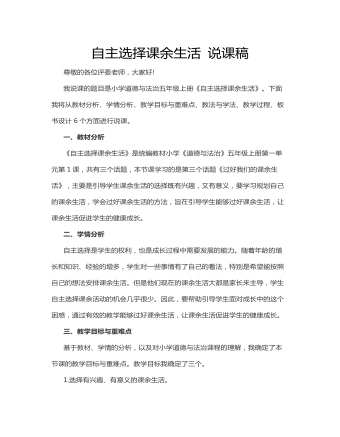
自主选择课余生活 说课稿
我说课的题目是小学道德与法治五年级上册《自主选择课余生活》。下面我将从教材分析、学情分析、教学目标与重难点、教法与学法、教学过程、板书设计6个方面进行说课。一、教材分析《自主选择课余生活》是统编教材小学《道德与法治》五年级上册第一单元第1课,共有三个话题,本节课学习的是第三个话题《过好我们的课余生活》,主要是引导学生课余生活的选择既有兴趣,又有意义,要学习规划自己的课余生活,学会过好课余生活的方法,旨在引导学生能够过好课余生活,让课余生活促进学生的健康成长。二、学情分析自主选择是学生的权利,也是成长过程中需要发展的能力。随着年龄的增长和知识、经验的增多,学生对一些事情有了自己的看法,特别是希望能按照自己的想法安排课余生活。但是他们现在的课余生活大都是家长来主导,学生自主选择课余活动的机会几乎很少。因此,要帮助引导学生面对成长中的这个困惑,通过有效的教学能够过好课余生活,让课余生活促进学生的健康成长。三、教学目标与重难点基于教材、学情的分析,以及对小学道德与法治课程的理解,我确定了本节课的教学目标与重难点。教学目标我确定了三个。
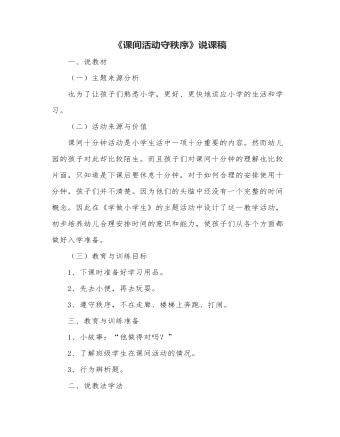
《课间活动守秩序》说课稿
三、说过程1、谈话导入。小朋友,每上完一节课都有十分钟的休息时间,着就是课间。在这课间十分钟,我们应该作些什么呢?怎样遵守课间秩序?2、听故事明道理。(1)讲小故事:“他做得对吗?”(2)讨论:同学们会怎样批评小刚?小刚哪些地方做得不对?(3)讨论后归纳:课间十分钟,小朋友要遵守秩序,做好三件事:先做好下节课学习用品的准备工作,放好凳子;然后去厕所;最后在去玩。(4)做一做a、组织听老师说步骤请全班学生依次做好三件事。b、听到模拟下课铃声请全班同学自己做好三件事。3、学儿歌明要求:(1)课间走路要做到:教室里轻轻走,走廊上慢慢走,转弯口减速走,上下楼梯靠右走。(2)课间玩耍要做到:不抢先,不霸道,不争吵,不打闹。互相谦让有礼貌,同学之间要友好。
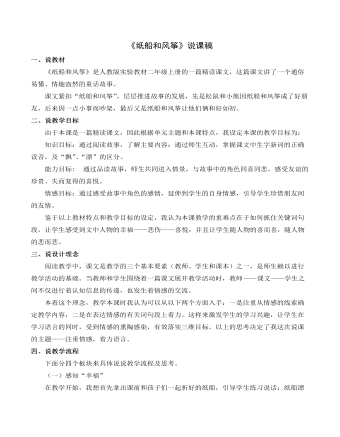
《纸船和风筝》说课稿
研读第三段。(出示第三段)首先我深情地描述第一、二段的文本内容自然而有情境地引入第三段。先是学生齐读完第三段后,接着老师发问,小熊拿到纸船,乐坏了,他乐得。让学生看图自己说说。二年级的孩子词汇量比较缺乏,我会为给他们搭好台阶,送给他们一些词语,比如手舞足蹈、眉开眼笑、兴高采烈、喜笑颜开……来丰富他们说话的内容。



